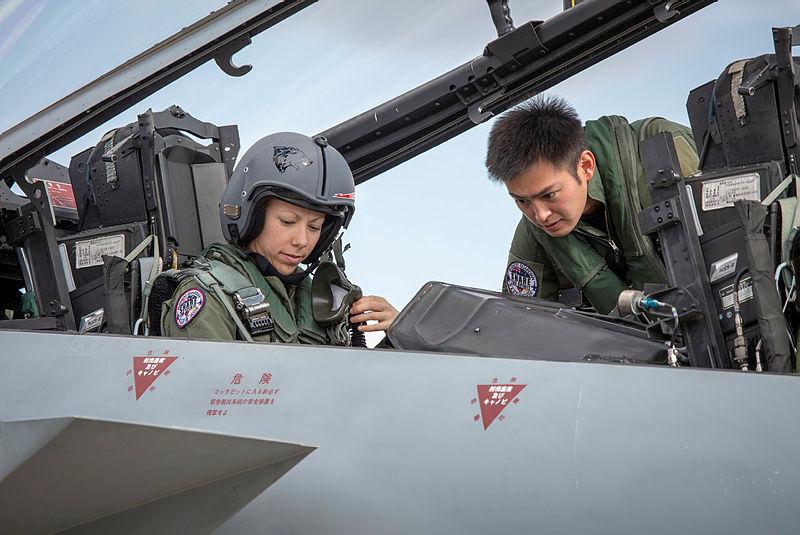The month in women, peace and security: October 2019
Posted By Sunny Cao, Sarah O’Connor and James Rickard on November 11, 2019 @ 13:24

Annual WPS stocktake
On 29 October the UN Security Council adopted resolution 2493 [1], reaffirming its commitment to the full and continuing implementation of all previous resolutions pertaining to WPS. Although the resolution was unanimously adopted by the 15 council members, American ambassador Kelly Craft told the Security Council that the US was unhappy [2] with references to sexual and reproductive health and the safe termination of pregnancies, positioning it against the UK, France, South Africa and others.
Sarah Taylor and Gretchen Baldwin of the International Peace Institute have written a report [3] on new opportunities for WPS to coincide with the adoption of resolution 2493. The report concludes that the international community should use creative mechanisms to support substantive progress in the WPS agenda by increasing women’s participation, increasing financing, making better use of the tools of the UN Security Council, and more.
The latest UN Secretary-General’s report [4] on WPS was released on 9 October ahead of the annual Security Council debate on the topic. The report found that ‘there remains a stark contrast between rhetoric and reality’ in the WPS agenda.
WPS Index report
Georgetown University’s Institute for Women, Peace and Security and the Peace Research Institute of Oslo have released a report [5] examining the performance of 167 countries in the WPS Index. It found that while women’s wellbeing had improved in almost 60 countries, it had deteriorated in many war-torn nations due to worsening security conditions.
A century of change
National Geographic has launched [6] ‘Women: a century of change’, a special issue to celebrate 100 years since US women won the right to vote. The issue looks at where women have been, where they are now and where they are going. Photojournalist Lynsey Addario considers [7] the role of women in the military as growing numbers of women take on active roles on the front lines of armed conflicts, and touches on the experiences of female fighters.
Experts first, women second
Caroline Baxter and Elizabeth Bodine-Baron organised the first Roberta Wohlstetter Forum on National Security. Despite initial fears that people would opt not to attend given the all-female panel, they found [8] turnout didn’t seem to be affected. They attribute this to their reference to the panellists as experts in their fields, rather than as women experts. Baxter and Bodine-Baron concluded that highlighting the sex of female speakers ‘shifts the focus away from the speakers’ expertise and toward the righting of a historic wrong’, and therefore culture must change so that women are no longer seen as ‘women first and experts second’.
Misogyny and extremist ideologies
The Monash Gender, Peace and Security Centre has published [9] a policy brief looking at the overlap between misogyny and violent extremism. Authors Melissa Johnston and Jacqui True provide a gender analysis of survey data collected in Indonesia, Bangladesh, the Philippines and Libya. They focus on the often overlooked relationship between attitudes and practices towards women and support for violent extremism. The authors found evidence that misogyny is integral to the ideology, political identity and political economy of violent extremist groups.
Networks for women mediators
In a recent piece, Quhramaana Kakar argues [10] that despite the increasingly active role women play in mediating conflicts, they are often not supported or acknowledged for that work. She stresses the importance of networks in helping increase the recognition of women mediators in peace processes, and highlights the new Global Alliance of Regional Women Mediator Networks [11], saying that its establishment is a ‘crucial step in publicly acknowledging and elevating the vital work women mediators are already doing’.
The privatisation of war and WPS
As the nexus between the WPS agenda and other security challenges becomes increasingly apparent, Marta Bautista Forcada highlights [12] the particular challenge of the privatisation of war through the use of military and security companies. Using cases [13] where contractors have committed gendered human-rights violations, she argues that gender-based violence in such companies is not an isolated phenomenon and that further research is needed to better address the challenges privatised war poses.
Gender perspectives and women in the military
In this Council on Foreign Relations article [14], US Marine Corps Reserve Lieutenant Colonel Jeannette Gaudry Haynie argues that more robust research is needed into the correlation between gender diversity and military effectiveness. Female soldiers observe things differently to their male counterparts and are often in a better position to gain the trust of local women in a combat zone. Haynie says ‘applying a gender lens can create a richer picture of the security situation, filling in gaps and informing leaders where existing assumptions might be unsound’.
Royal Australian Air Force Wing Commander Angeline Lewis has written [15] for The Strategist on the need to develop a clear understanding of the relationship between the WPS agenda and women’s participation in the Australian Defence Force in the context of operations. Lewis argues that more research should be done on the skills and capability required to implement WPS and on the balance between thematic gender expertise and country-specific gender knowledge in the military context.
Article printed from The Strategist: https://aspistrategist.ru
URL to article: /the-month-in-women-peace-and-security-october-2019/
URLs in this post:
[1] resolution 2493: https://undocs.org/S/RES/2493(2019)
[2] unhappy: https://www.reuters.com/article/us-women-rights-usa-un/u-s-pitted-against-britain-france-south-africa-others-at-u-n-over-abortion-idUSKBN1X829K
[3] report: https://www.ipinst.org/2019/10/focus-on-2020-opportunities-for-the-twentieth-anniversary-of-resolution-1325
[4] report: https://www.securitycouncilreport.org/atf/cf/%7B65BFCF9B-6D27-4E9C-8CD3-CF6E4FF96FF9%7D/s_2019_800.pdf
[5] report: http://giwps.georgetown.edu/resource/wps-index-2019-20/
[6] launched: https://www.nationalgeographic.com/magazine/2019/11/
[7] considers: https://www.nationalgeographic.com/culture/2019/10/women-are-in-the-fight-on-todays-battlefields-feature/
[8] found: https://www.rand.org/blog/2019/10/stop-calling-us-women-experts.html
[9] published: https://arts.monash.edu/__data/assets/pdf_file/0007/2003389/Policy-Brief_VE_and_VAW_V7t.pdf
[10] argues: https://www.peacenews.com/single-post/2019/10/29/Op-Ed-How-women-mediators-can-amplify-their-work
[11] Global Alliance of Regional Women Mediator Networks: https://www.prio.org/News/Item/?x=2446
[12] highlights: https://theglobalobservatory.org/2019/10/privatization-of-war-new-challenge-for-women-peace-security-agenda/
[13] cases: https://www.ohchr.org/Documents/Issues/Mercenaries/WG/Gender/WILPF_PMSCs_Gender.pdf
[14] article: https://www.cfr.org/blog/through-gender-lens-need-robust-research-diversity-and-military-effectiveness
[15] written: /women-in-the-australian-defence-force-getting-beyond-the-assumptions/
Click here to print.